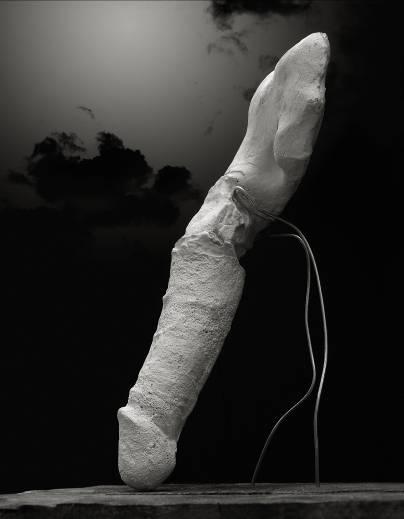
1. The innermost parts of a building, especially the sanctuary of a temple.
2. The most private or secret parts; recesses: the penetralia of the soul.
In this exhibition of new sculpture, her first in London since Perceval at the Serpentine Gallery in 2006, British artist Sarah Lucas exhibits a series of objects assembled from plaster casts of penises and flint. The variations on this formal starting point are like the haul of an archeological dig in the manner of a collection of Cycladic torsos or polytheistic relics, the repetition underlining its potency and timelessness, and the dynamism of the phallus as metaphor. The combination of the casts with flint references the presence of flint objects in the vaults and cabinets of archeological museums, mostly as examples of early weapons or fire-making tools, which marry with the potential power in an erection.
The Penetralia sculptures sit comfortably in the context of Sarah Lucas’ body of work, its principal position a challenge to ideas of gender stereotypes and sexual allegory. These new sculptures can be seen as the dogged examination of the phallic form itself, set out for consideration of shape and loaded subject. Lucas has justified the use of the cock and balls in her work in the past, an early example being Things from 1992, a wire penis covered with unlit matches or the papier-mâché collage Cock and Spare Balls of the following year, claiming the male organ to be the perfect stand-alone readymade sculpture. Beer Can Penis, an unlimited series started at the Köln Art Fair in 1998, was made by Lucas for customers at the fair by splicing two beer cans together to form the required shape, and in these previous sculptures the potent sexual content was as central a component in her work as the formal experiment. The linguistic element in Lucas’ work is always as loaded as her choice of material, the title of her 1990 show Penis Nailed to Board being a good example of her mastery. This exhibition’s title, Penetralia, is a real word that is both serious and evocative, and above all suggestive. This play on words continues subversively in the sculptures themselves, with their bone(r)-like form a colloquial pun on erection.
In the materials and the sense of authenticity of production in Lucas’ work is the heritage of Arte Povera - these works are roughly cast by the artist in plaster, presented on found timber blocks with wire supports - and Lucas has repeatedly used all these materials in her work to date, along with concrete, collage, cardboard, domestic furniture, fruit and vegetables, sanitary ware, cigarettes and underwear. It is often mistakenly stated that her work is coarse and casual assemblage, but there is a precision in her nonchalant and particular touch - how Lucas articulates her work defies reproduction. In the case of the Penetralia sculptures, their physical improbability is part of their totem-like magic and there is a pointed contrast between the transitoriness of catching the erection and of museological attempts to hang on to and preserve impossible things. In turn, the evidence of the piece being made (in some of the sculptures bits have snapped off and been stuck back on) is evocative of a strange and shamanistic ritual, a performance by artist and model.
A special artists’ book by Sarah Lucas and Julian Simmons, made as a companion to the exhibition, will be available in a small signed edition.
Sarah Lucas was born in Islington, London in 1962 and studied at Goldsmiths College, London. This exhibition of new sculptures follows her survey exhibition at Kunsthalle Zürich, Switzerland, Kunstverein Hamburg, Germany, and Tate Liverpool, UK, in 2005-06 on which occasion a complete catalogue raisonné was published. She lives and works in Suffolk, UK.
For press information please contact Chelsea@sadiecoles.com, Chelsea Zaharczuk on +44 20 7493 8611.
